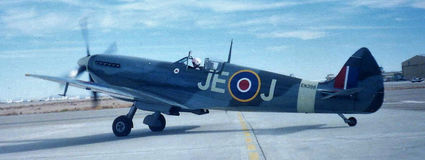A Spitfire at Mojave in 2007 and 2019
Short Flights
August 31, 2019
The aircraft in the photo is a rare Supermarine Spitfire Mk. IXc/e that underwent flight testing here at Mojave Airport over a decade ago before it was shipped to the TAM Air Museum Americana in Brazil.
The Supermarine Spitfire is a legend in British aviation history and along with the Hawker Hurricane, successfully defended England in the Battle of Britain (1940-1941) against Germany's Luftwaffe.
We were so lucky to actually hear the "Spit" flying over Mojave in July 2007. It was painted in the RCAF camouflage scheme and looking as though it just flew through a time warp from 1941.
The Spitfire pictured in this article had been acquired by David Price of the Santa Monica Museum of Flying sometime after 1987. This very aircraft is the only Spitfire flying that actually operated with the U.S. Army Air Corps during WWII.
It was delivered to 6 MU (Maintenance Unit) in July 1943, and then was sent to the Mediterranean to operate with the Allied Air Force. Later, it was transferred to the United States Army Air Corps and was flown between October 1943 and May 1944.
After the war, it was sold to South Africa and wasn't flown. This magnificent bird was stripped of parts and ended up being sold for £3 to be used as a piece of playground equipment!
Fortunately it was spotted from the air by some good Samaritans in 1967 and was finally returned to flying condition in 1975. It was shipped to California in 1986 or 1987 and was registered as N930LB.
The paint scheme chosen depicts the famous aircraft flown by RCAF (Royal Canadian Air Force) Wing Commander "Johnnie" Johnson, with serial number EN398 and Johnson's initials JEJ on the side of the fuselage.
Johnson had a total wartime score of 34 confirmed kills, seven shared, three probable (and two shared), 10 damaged (and three shared) and one shared on the ground during WWII. He began flying EN398 on March 16, 1943 and by the end of May had added six victories and one shared victory to his score. In June, Johnson destroyed two FW-190s and damaged a Me-109.
Johnson's shooting skills were far above average and he had his aircraft's weapons harmonized to a single point, rather than spreading out over a circle that was a few feet across.
Powered by a Rolls Royce V-12 engine (called "Merlin" because it was considered to be magic), had a top speed of 355 to 451 mph. It had a graceful elliptical wing with a thin airfoil that, in combination with the Merlin's efficient two-stage supercharger, gave it exceptional performance at high altitudes.

From the beginning to the end of WWII, 20,000 Spitfires were produced with around 40 different variants. The wingspan ranged from standard 36-feet, 10-inches, to clipped 32-feet, 7-inches and was even extended to 40-feet, 2-inches, depending on the Mark variant. Its length ranged from 29-feet, 11-inches to 34-feet, 4-inches, and its height ranged from 11-feet, 5-inches to 12-feet, 9-inches. The weight ranged from 4810 pounds all the way up to 12,750 pounds, depending on its ordnance load.
Another Spitfire will be coming to Mojave on Saturday, August 31 and you don't want to miss seeing it! The 1943 Silver Spitfire Mk-IX from the United Kingdom is circumnavigating the world and departed England on August 5, 2019.
Two British aviation enthusiasts, Matt Jones and Steve Brooks, took off in a polished silver Spitfire Mark IX from southern England, headed north-west on The Longest Flight and will return to Blighty by Christmas having pushed the aircraft to new limits.
When they touch back down, they will have made more than 150 stops in over 30 countries, soaring over many airspaces the Spitfire has never before entered and flying over territories, such as the Far East and North Africa, where it hasn't been seen since the war ended.
Named Silver Spitfire – The Longest Flight, the concept is the brainchild of not only Jones and Brooks but a small and dedicated team of enthusiasts, among them Lachlan Monro, the project director, and Gerry Jones, the group's chief engineer – both of whom will be following the aircraft around the world in a small PC-12 support plane.
See you on our next flight!




